formerly eScholarship Editions


|
|
|
|
Your search for
'Music' in subject
found 59 book(s). | Modify Search | Displaying 41 - 59 of 59 book(s) | |
| 41. | 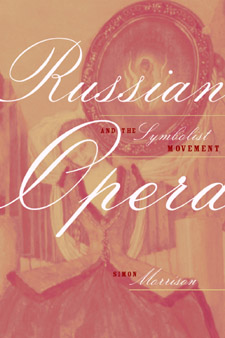 | Title: Russian opera and the symbolist movement Author: Morrison, Simon Alexander 1964- Published: University of California Press, 2002 Subjects: Music | Opera | Musicology | Composers | Russian and Eastern European Studies | Literature Publisher's Description: An aesthetic, historical, and theoretical study of four scores, Russian Opera and the Symbolist Movement is a groundbreaking and imaginative treatment of the important yet neglected topic of Russian opera in the Silver Age. Spanning the gap between the supernatural Russian music of the nineteenth century and the compositions of Prokofiev and Stravinsky, this exceptionally insightful and well-researched book explores how Russian symbolist poets interpreted opera and prompted operatic innovation. Simon Morrison shows how these works, though stylistically and technically different, reveal the extent to which the operatic representation of the miraculous can be translated into its enactment. Morrison treats these largely unstudied pieces by canonical composers: Tchaikovsky's Queen of Spades, Rimsky-Korsakov's Legend of the Invisible City of Kitezh and the Maiden Fevroniya, Scriabin's unfinished Mysterium, and Prokofiev's Fiery Angel. The chapters, revisionist studies of these composers and scores, address separate aspects of Symbolist poetics, discussing such topics as literary and musical decadence, pagan-Christian syncretism, theurgy, and life creation, or the portrayal of art in life. The appendix offers the first complete English-language translation of Scriabin's libretto for the Preparatory Act. Providing valuable insight into both the Symbolist enterprise and Russian musicology, this book casts new light on opera's evolving, ambiguous place in fin de siècle culture. [brief] Similar Items |
| 42. | 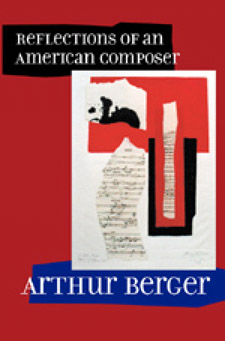 | Title: Reflections of an American composer Author: Berger, Arthur 1912- Published: University of California Press, 2002 Subjects: Music | American Music | Classical Music | Contemporary Music | Composers | Musicology Publisher's Description: In this engrossing collection of essays, distinguished composer, theorist, journalist, and educator Arthur Berger invites us into the vibrant and ever-changing American music scene that has been his home for most of the twentieth century. Witty, urbane, and always entertaining, Berger describes the music scene in New York and Boston since the 1930s, discussing the heady days when he was a member of a tight-knit circle of avant-garde young composers mentored by Aaron Copland as well as his participation in a group at Harvard University dedicated to Stravinsky. As Virgil Thomson's associate on the New York Herald Tribune and founding editor of the prestigious Perspectives of New Music, Berger became one of the preeminent observers and critics of American music. His reflections on the role of music in contemporary life, his journalism career, and how changes in academia influence the composition and teaching of music offer a unique perspective informed by Berger's abundant intelligence and experience. [brief] Similar Items |
| 43. | 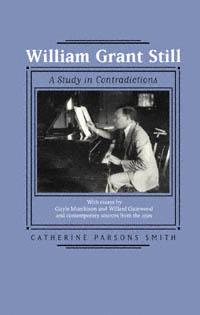 | Title: William Grant Still: a study in contradictions Author: Smith, Catherine Parsons 1933- Published: University of California Press, 2000 Subjects: Music | Composers | African American Studies | Autobiographies and Biographies Publisher's Description: During the 1930s and 1940s William Grant Still (1895-1978) was known as the "Dean of Afro-American Composers." He worked as an arranger for early radio, on Broadway, and in Hollywood; major symphony orchestras performed his concert works; and an opera, written in collaboration with Langston Hughes, was produced by the New York City Opera. Despite these successes the composer's name gradually faded into obscurity. This book brings William Grant Still out of the archives and examines his place in America's musical heritage. It also provides a revealing window into our recent cultural past.Until now Still's profound musical creativity and cultural awareness have been obscured by the controversies that dogged much of his personal and professional life. New topics explored by Catherine Parsons Smith and her contributors include the genesis of the Afro American Symphony , Still's best-known work; his troubled years in film and opera; and his outspoken anticommunism. [brief] Similar Items |
| 44. | 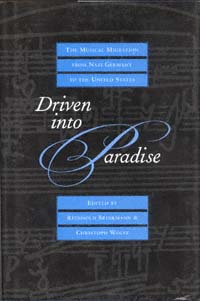 | Title: Driven into paradise: the musical migration from Nazi Germany to the United States Author: Brinkmann, Reinhold 1934- Published: University of California Press, 1999 Subjects: Music | American Music | Composers | Musicology | European History | United States History Publisher's Description: The forced migration of artists and scholars from Nazi Germany is a compelling and often wrenching story. The story is twofold, of impoverishment for the countries the musicians left behind and enrichment for the United States. The latter is the focus of this eminent collection, which approaches the subject from diverse perspectives, including documentary-style newspaper accounts and an exploration of Walt Whitman's poetry in the work of Paul Hindemith and Kurt Weill.The flood of musical migration from Germany and Austria from 1933 to 1944 had a lasting impact. Hundreds of musicians and musicologists came to the United States and remained here, and the shaping power of their talents is incalculable. Several essays provide firsthand insights into aspects of American cultural history to which these émigrés made essential contributions as conductors, professors, and composers; other essays tell of the traumatic experience of being exiled and the difficulties of finding one's way in a foreign country. While the migration infused the U.S. with a distinctly European musical awareness, at the same time the status and authority of its participants tended to intervene in the development of a genuinely American cultural voice. The story of the unprecedented migration that resulted from Nazism has many dimensions, and Driven Into Paradise illuminates them in deeply human terms. [brief] Similar Items |
| 45. | 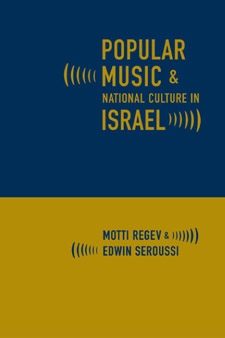 | Title: Popular music and national culture in Israel Author: Regev, Motti Published: University of California Press, 2004 Subjects: Music | Ethnomusicology | Middle Eastern Studies | Popular Culture | Jewish Studies Publisher's Description: A unique Israeli national culture - indeed, the very nature of "Israeliness" - remains a matter of debate, a struggle to blend vying memories and backgrounds, ideologies and wills. Identifying popular music as an important site in this wider cultural endeavor, this book focuses on the three major popular music cultures that are proving instrumental in attempts to invent Israeliness: the invented folk song repertoire known as Shirei Eretz Israel; the contemporary, global-cosmopolitan Israeli rock; and the ethnic-oriental musica mizrahit. The result is the first ever comprehensive study of popular music in Israel. Motti Regev, a sociologist, and Edwin Seroussi, an ethnomusicologist, approach their subject from alternative perspectives, producing a truly interdisciplinary, sociocultural account of music as a feature and a force in the shaping of Israeliness. A major ethnographic undertaking, describing and analyzing the particular history, characteristics, and practices of each music culture, Popular Music and National Culture in Israel maps not only the complex field of Israeli popular music but also Israeli culture in general. [brief] Similar Items |
| 46. | 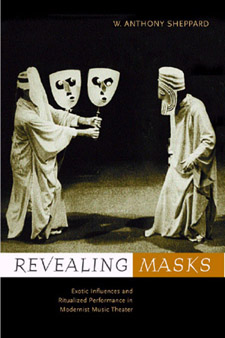 | Title: Revealing masks: exotic influences and ritualized performance in modernist music theater Author: Sheppard, William Anthony 1969- Published: University of California Press, 2001 Subjects: Music | American Music | Contemporary Music | Ethnomusicology | Opera | Musicology | Intellectual History Publisher's Description: W. Anthony Sheppard considers a wide-ranging constellation of important musical works in this fascinating exploration of ritualized performance in twentieth-century music. Revealing Masks uncovers the range of political, didactic, and aesthetic intents that inspired the creators of modernist music theater. Sheppard is especially interested in the use of the "exotic" in techniques of masking and stylization, identifying Japanese Noh, medieval Christian drama, and ancient Greek theater as the most prominent exotic models for the creation of "total theater." Drawing on an extraordinarily diverse - and in some instances, little-known - range of music theater pieces, Sheppard cites the work of Igor Stravinsky, Benjamin Britten, Arthur Honegger, Peter Maxwell Davies, Harry Partch, and Leonard Bernstein, as well as Andrew Lloyd Webber and Madonna. Artists in literature, theater, and dance - such as William Butler Yeats, Paul Claudel, Bertolt Brecht, Isadora Duncan, Ida Rubenstein, and Edward Gordon Craig--also play a significant role in this study. Sheppard poses challenging questions that will interest readers beyond those in the field of music scholarship. For example, what is the effect on the audience and the performers of depersonalizing ritual elements? Does borrowing from foreign cultures inevitably amount to a kind of predatory appropriation? Revealing Masks shows that compositional concerns and cultural themes manifested in music theater are central to the history of twentieth-century Euro-American music, drama, and dance. [brief] Similar Items |
| 47. | 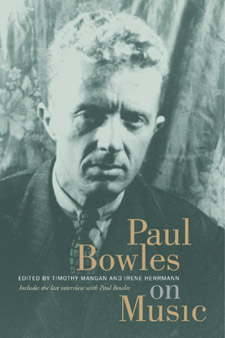 | Title: Paul Bowles on music Author: Bowles, Paul 1910- Published: University of California Press, 2003 Subjects: Music | American Music | Composers | Contemporary Music | American Literature | Film Publisher's Description: "It's an easy enough job if one has something to say," Paul Bowles remarked in a letter to his mother about his first foray into music criticism. And Paul Bowles, indeed, had plenty to say about music. Though known chiefly as a writer of novels and stories, Paul Bowles (1910-99) thought of himself first and foremost as a composer. Drawing together the work he did at the intersection of his two passions and professions, writing and music, this volume collects the music criticism Bowles published between 1935 and 1946 as well as an interview conducted by Irene Herrmann shortly before his death. An intimate of Aaron Copland and protégé of Virgil Thomson, Bowles was a musical sophisticate acquainted with an enormous range of music. His criticism collected here brilliantly illuminates not only the whole range of modernist composition but also film music, jazz, Mexican and Moroccan music, and many other genres. As a reviewer he reports on established artists and young hopefuls, symphonic concerts indoors and out, and important premieres of works by Copland, Thomson, Cage, Shostakovich, and Stravinsky, among others. Written with the austere grace of his better-known literary works, Bowles's criticism enhances our picture of an important era in American music history as well as our sense of his accomplishments and extraordinary contribution to twentieth-century culture. [brief] Similar Items |
| 48. | 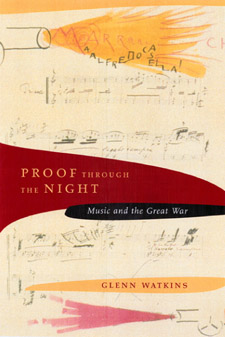 | Title: Proof through the night: music and the great war Author: Watkins, Glenn 1927- Published: University of California Press, 2002 Subjects: Music | Musicology | American Music | European History | United States History Publisher's Description: Carols floating across no-man's-land on Christmas Eve 1914; solemn choruses, marches, and popular songs responding to the call of propaganda ministries and war charities; opera, keyboard suites, ragtime, and concertos for the left hand - all provided testimony to the unique power of music to chronicle the Great War and to memorialize its battles and fallen heroes in the first post-Armistice decade. In this striking book, Glenn Watkins investigates these variable roles of music primarily from the angle of the Entente nations' perceived threat of German hegemony in matters of intellectual and artistic accomplishment - a principal concern not only for Europe but also for the United States, whose late entrance into the fray prompted a renewed interest in defining America as an emergent world power as well as a fledgling musical culture. He shows that each nation gave "proof through the night" - ringing evidence during the dark hours of the war - not only of its nationalist resolve in the singing of national airs but also of its power to recall home and hearth on distant battlefields and to reflect upon loss long after the guns had been silenced. Watkins's eloquent narrative argues that twentieth-century Modernism was not launched full force with the advent of the Great War but rather was challenged by a new set of alternatives to the prewar avant-garde. His central focus on music as a cultural marker during the First World War of necessity exposes its relationship to the other arts, national institutions, and international politics. From wartime scores by Debussy and Stravinsky to telling retrospective works by Berg, Ravel, and Britten; from "La Marseillaise" to "The Star-Spangled Banner," from "It's a Long Way to Tipperary" to "Over There," music reflected society's profoundest doubts and aspirations. By turns it challenged or supported the legitimacy of war, chronicled misgivings in miniature and grandiose formats alike, and inevitably expressed its sorrow at the final price exacted by the Great War. Proof through the Night concludes with a consideration of the post-Armistice period when, on the classical music front, memory and distance forged a musical response that was frequently more powerful than in wartime. [brief] Similar Items |
| 49. | 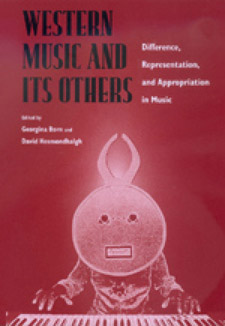 | Title: Western music and its others: difference, representation, and appropriation in music Author: Born, Georgina Published: University of California Press, 2000 Subjects: Music | Ethnomusicology | Cultural Anthropology | Sociology | Postcolonial Studies | Popular Culture Publisher's Description: This innovative collection of articles offers a major comprehensive overview of new developments in cultural theory as applied to Western music. Addressing a broad range of primarily twentieth-century music, the authors examine two related phenomena: musical borrowings or appropriations, and how music has been used to construct, evoke, or represent difference of a musical or a sociocultural kind. The essays scrutinize a diverse body of music and discuss a range of significant examples, among them musical modernism's idealizing or ambivalent relations with popular, ethnic, and non-Western music; exoticism and orientalism in the experimental music tradition; the representation of others in Hollywood film music; music's role in the formation and contestation of collective identities, with reference to Jewish and Turkish popular music; and issues of representation and difference in jazz, world music, hip hop, and electronic dance music. Written by leading scholars from disciplines including historical musicology, sociology, ethnomusicology, anthropology, popular music studies, and film studies, the essays provide unprecedented insights into how cultural identities and differences are constructed in music. [brief] Similar Items |
| 50. | 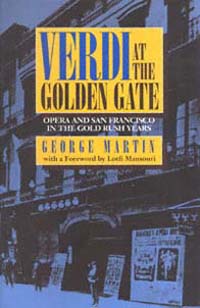 | Title: Verdi at the Golden Gate: opera and San Francisco in the Gold Rush years Author: Martin, George Whitney Published: University of California Press, 1993 Subjects: Music | History | Opera | Composers | American Studies | California and the West | European History Publisher's Description: Opera is a fragile, complex art, but it flourished extravagantly in San Francisco during the Gold Rush years, a time when daily life in the city was filled with gambling, duels, murder, and suicide. In the history of the United States there has never been a rougher town than Gold Rush San Francisco, yet there has never been a greater frenzy for opera than developed there in these exciting years.How did this madness for opera take root and grow? Why did the audience's generally drunken, brawling behavior gradually improve? How and why did Verdi emerge as the city's favorite composer? These are the intriguing themes of George Martin's enlightening and wonderfully entertaining story. Among the incidents recounted are the fist fight that stopped an opera performance and ended in a fatal duel; and the brothel madam who, by sitting in the wrong row of a theater, caused a fracas that resulted in the formation of the Vigilantes of 1856.Martin weaves together meticulously gathered social, political, and musical facts to create this lively cultural history. His study contributes to a new understanding of urban culture in the Jacksonian?Manifest Destiny eras, and of the role of opera in cities during this time, especially in the American West. Over it all soars Verdi's somber, romantic music, capturing the melancholy, the feverish joy, and the idealism of his listeners. [brief] Similar Items |
| 51. | 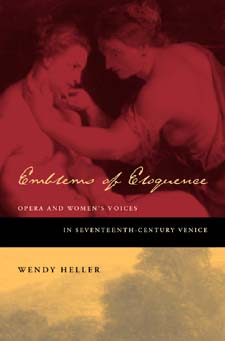 | Title: Emblems of eloquence: opera and women's voices in seventeenth-century Venice Author: Heller, Wendy Beth Published: University of California Press, 2004 Subjects: Music | European Studies | Opera | Classical Music | Women's Studies | Classical Literature and Language | Renaissance History Publisher's Description: Opera developed during a time when the position of women - their rights and freedoms, their virtues and vices, and even the most basic substance of their sexuality - was constantly debated. Many of these controversies manifested themselves in the representation of the historical and mythological women whose voices were heard on the Venetian operatic stage. Drawing upon a complex web of early modern sources and ancient texts, this engaging study is the first comprehensive treatment of women, gender, and sexuality in seventeenth-century opera. Wendy Heller explores the operatic manifestations of female chastity, power, transvestism, androgyny, and desire, showing how the emerging genre was shaped by and infused with the Republic's taste for the erotic and its ambivalent attitudes toward women and sexuality. Heller begins by examining contemporary Venetian writings about gender and sexuality that influenced the development of female vocality in opera. The Venetian reception and transformation of ancient texts - by Ovid, Virgil, Tacitus, and Diodorus Siculus - form the background for her penetrating analyses of the musical and dramatic representation of five extraordinary women as presented in operas by Claudio Monteverdi, Francesco Cavalli, and their successors in Venice: Dido, queen of Carthage (Cavalli); Octavia, wife of Nero (Monteverdi); the nymph Callisto (Cavalli); Queen Semiramis of Assyria (Pietro Andrea Ziani); and Messalina, wife of Claudius (Carlo Pallavicino). [brief] Similar Items |
| 52. | 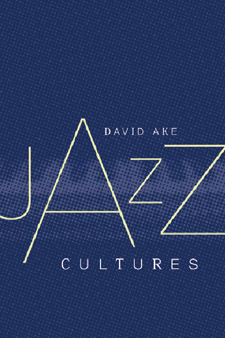 | Title: Jazz cultures Author: Ake, David Andrew 1961- Published: University of California Press, 2002 Subjects: Music | American Music | Jazz | Ethnomusicology | American Studies | African American Studies | Jazz Publisher's Description: From its beginning, jazz has presented a contradictory social world: jazz musicians have worked diligently to erase old boundaries, but they have just as resolutely constructed new ones. David Ake's vibrant and original book considers the diverse musics and related identities that jazz communities have shaped over the course of the twentieth century, exploring the many ways in which jazz musicians and audiences experience and understand themselves, their music, their communities, and the world at large. Writing as a professional pianist and composer, the author looks at evolving meanings, values, and ideals--as well as the sounds--that musicians, audiences, and critics carry to and from the various activities they call jazz. Among the compelling topics he discusses is the "visuality" of music: the relationship between performance demeanor and musical meaning. Focusing on pianists Bill Evans and Keith Jarrett, Ake investigates the ways in which musicians' postures and attitudes influence perceptions of them as profound and serious artists. In another essay, Ake examines the musical values and ideals promulgated by college jazz education programs through a consideration of saxophonist John Coltrane. He also discusses the concept of the jazz "standard" in the 1990s and the differing sense of tradition implied in recent recordings by Wynton Marsalis and Bill Frisell. Jazz Cultures shows how jazz history has not consisted simply of a smoothly evolving series of musical styles, but rather an array of individuals and communities engaging with disparate--and oftentimes conflicting--actions, ideals, and attitudes. [brief] Similar Items |
| 53. | 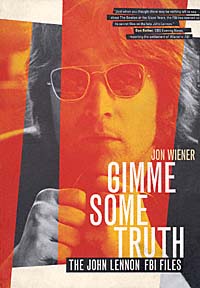 | Title: Gimme some truth: the John Lennon FBI files Author: Wiener, Jon Published: University of California Press, 2000 Subjects: American Studies | Politics | Sociology | Social Problems | Music | Social Theory | Cultural Anthropology | Law Publisher's Description: When FBI Director J. Edgar Hoover reported to the Nixon White House in 1972 about the Bureau's surveillance of John Lennon, he began by explaining that Lennon was a "former member of the Beatles singing group." When a copy of this letter arrived in response to Jon Wiener's 1981 Freedom of Information request, the entire text was withheld - along with almost 200 other pages - on the grounds that releasing it would endanger national security. This book tells the story of the author's remarkable fourteen-year court battle to win release of the Lennon files under the Freedom of Information Act in a case that went all the way to the Supreme Court. With the publication of Gimme Some Truth , 100 key pages of the Lennon FBI file are available - complete and unexpurgated, fully annotated and presented in a "before and after" format.Lennon's file was compiled in 1972, when the war in Vietnam was at its peak, when Nixon was facing reelection, and when the "clever Beatle" was living in New York and joining up with the New Left and the anti-war movement. The Nixon administration's efforts to "neutralize" Lennon are the subject of Lennon's file. The documents are reproduced in facsimile so that readers can see all the classification stamps, marginal notes, blacked out passages and - in some cases - the initials of J. Edgar Hoover. The file includes lengthy reports by confidential informants detailing the daily lives of anti-war activists, memos to the White House, transcripts of TV shows on which Lennon appeared, and a proposal that Lennon be arrested by local police on drug charges.Fascinating, engrossing, at points hilarious and absurd, Gimme Some Truth documents an era when rock music seemed to have real political force and when youth culture challenged the status quo in Washington. It also delineates the ways the Reagan, Bush, and Clinton administrations fought to preserve government secrecy, and highlights the legal strategies adopted by those who have challenged it. [brief] Similar Items |
| 54. | 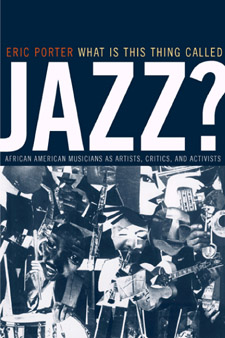 | Title: What is this thing called jazz?: African American musicians as artists, critics, and activists Author: Porter, Eric (Eric C.) Published: University of California Press, 2002 Subjects: Music | History | United States History | American Studies | African American Studies | American Music | Contemporary Music | Jazz Publisher's Description: Despite the plethora of writing about jazz, little attention has been paid to what musicians themselves wrote and said about their practice. An implicit division of labor has emerged where, for the most part, black artists invent and play music while white writers provide the commentary. Eric Porter overturns this tendency in his creative intellectual history of African American musicians. He foregrounds the often-ignored ideas of these artists, analyzing them in the context of meanings circulating around jazz, as well as in relationship to broader currents in African American thought. Porter examines several crucial moments in the history of jazz: the formative years of the 1920s and 1930s; the emergence of bebop; the political and experimental projects of the 1950s, 1960s and 1970s; and the debates surrounding Jazz at Lincoln Center under the direction of Wynton Marsalis. Louis Armstrong, Anthony Braxton, Marion Brown, Duke Ellington, W.C. Handy, Yusef Lateef, Abbey Lincoln, Charles Mingus, Archie Shepp, Wadada Leo Smith, Mary Lou Williams, and Reggie Workman also feature prominently in this book. The wealth of information Porter uncovers shows how these musicians have expressed themselves in print; actively shaped the institutional structures through which the music is created, distributed, and consumed, and how they aligned themselves with other artists and activists, and how they were influenced by forces of class and gender. What Is This Thing Called Jazz? challenges interpretive orthodoxies by showing how much black jazz musicians have struggled against both the racism of the dominant culture and the prescriptive definitions of racial authenticity propagated by the music's supporters, both white and black. [brief] Similar Items |
| 55. | 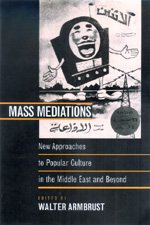 | Title: Mass mediations: new approaches to popular culture in the Middle East and beyond Author: Armbrust, Walter Published: University of California Press, 2000 Subjects: Middle Eastern Studies | Anthropology | Cultural Anthropology | Media Studies | Music | Cinema and Performance Arts Publisher's Description: Offering a stimulating diversity of perspectives, this collection examines how popular culture through mass media defines the scale and character of social interaction in the Middle East. The contributors approach popular culture broadly, with an interest in how it creates new scales of communication and new dimensions of identity that affect economics, politics, aesthetics, and performance. Reflected in these essays is the fact that mass media are as ubiquitous in Cairo and Karachi as in Los Angeles and Detroit. From Persian popular music in Beverly Hills to Egyptians' reaction to a recent film on Gamal Abdel Nasser; from postmodern Turkish novels to the music of an Israeli transsexual singer, the essays illustrate the multiple contexts of modern cultural production. The unfolding of modernity in colonial and postcolonial societies has been little analyzed until now. In addressing transnational aspects of Middle Eastern societies, the contributors also challenge conventional assumptions about the region and its relation to the West. The volume will have wide appeal both to Middle Eastern scholars and to readers interested in global and cultural studies. [brief] Similar Items |
| 56. | 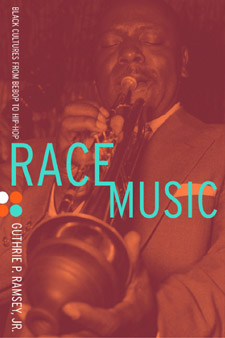 | Title: Race music: black cultures from bebop to hip-hop Author: Ramsey, Guthrie P Published: University of California Press, 2003 Subjects: Music | American Music | American Studies | Popular Music | United States History | Ethnomusicology | African American Studies Publisher's Description: This powerful book covers the vast and various terrain of African American music, from bebop to hip-hop. Guthrie P. Ramsey, Jr., begins with an absorbing account of his own musical experiences with family and friends on the South Side of Chicago, evoking Sunday-morning worship services, family gatherings with food and dancing, and jam sessions at local nightclubs. This lays the foundation for a brilliant discussion of how musical meaning emerges in the private and communal realms of lived experience and how African American music has shaped and reflected identities in the black community. Deeply informed by Ramsey's experience as an accomplished musician, a sophisticated cultural theorist, and an enthusiast brought up in the community he discusses, Race Music explores the global influence and popularity of African American music, its social relevance, and key questions regarding its interpretation and criticism. Beginning with jazz, rhythm and blues, and gospel, this book demonstrates that while each genre of music is distinct - possessing its own conventions, performance practices, and formal qualities - each is also grounded in similar techniques and conceptual frameworks identified with African American musical traditions. Ramsey provides vivid glimpses of the careers of Dinah Washington, Louis Jordan, Dizzy Gillespie, Cootie Williams, and Mahalia Jackson, among others, to show how the social changes of the 1940s elicited an Afro-modernism that inspired much of the music and culture that followed. Race Music illustrates how, by transcending the boundaries between genres, black communities bridged generational divides and passed down knowledge of musical forms and styles. It also considers how the discourse of soul music contributed to the vibrant social climate of the Black Power Era. Multilayered and masterfully written, Race Music provides a dynamic framework for rethinking the many facets of African American music and the ethnocentric energy that infused its creation. [brief] Similar Items |
| 57. | 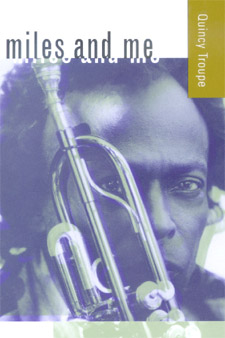 | Title: Miles and me Author: Troupe, Quincy Published: University of California Press, 2000 Subjects: Music | African American Studies | Autobiographies and Biographies | Contemporary Music | Jazz Publisher's Description: Quincy Troupe's candid account of his friendship with Miles Davis is a revealing portrait of a great musician and an intimate study of a unique relationship. It is also an engrossing chronicle of the author's own development, both artistic and personal. As Davis's collaborator on Miles: The Autobiography, Troupe--one of the major poets to emerge from the 1960s--had exceptional access to the musician. This memoir goes beyond the life portrayed in the autobiography to describe in detail the processes of Davis's spectacular creativity and the joys and difficulties his passionate, contradictory temperament posed to the men's friendship. It shows how Miles Davis, both as a black man and an artist, influenced not only Quincy Troupe but whole generations. Troupe has written that Miles Davis was "irascible, contemptuous, brutally honest, ill-tempered when things didn't go his way, complex, fair-minded, humble, kind and a son-of-a-bitch." The author's love and appreciation for Davis make him a keen, though not uncritical, observer. He captures and conveys the power of the musician's presence, the mesmerizing force of his personality, and the restless energy that lay at the root of his creativity. He also shows Davis's lighter side: cooking, prowling the streets of Manhattan, painting, riding his horse at his Malibu home. Troupe discusses Davis's musical output, situating his albums in the context of the times--both political and musical--out of which they emerged. Miles and Me is an unparalleled look at the act of creation and the forces behind it, at how the innovations of one person can inspire both those he knows and loves and the world at large. [brief] Similar Items |
| 58. | 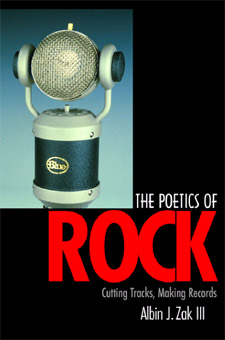 | Title: The poetics of rock: cutting tracks, making records Author: Zak, Albin Published: University of California Press, 2001 Subjects: Music | Popular Music | American Music | Musicology | Contemporary Music | American Studies | Media Studies | Popular Music Publisher's Description: After a hundred years of recording, the process of making records is still mysterious to most people who listen to them. Records hold a fundamental place in the dynamics of modern musical life, but what do they represent? Are they documents? Snapshots? Artworks? Fetishes? Commodities? Conveniences? The Poetics of Rock is a fascinating exploration of recording consciousness and compositional process from the perspective of those who make records. In it, Albin Zak examines the crucial roles played by recording technologies in the construction of rock music and shows how songwriters, musicians, engineers, and producers contribute to the creative project, and how they all leave their mark on the finished work. Zak shapes an image of the compositional milieu by exploring its elements and discussing the issues and concerns faced by artists. Using their testimony to illuminate the nature of record making and of records themselves, he shows that the art of making rock records is a collaborative compositional process that includes many skills and sensibilities not traditionally associated with musical composition. Zak connects all the topics--whether technical, conceptual, aesthetic, or historical--with specific artists and recordings and illustrates them with citations from artists and with musical examples. In lively and engaging prose, The Poetics of Rock brilliantly illustrates how the musical energy from a moment of human expression translates into a musical work wrought in sound. [brief] Similar Items |
| 59. | 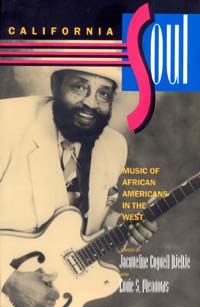 | Title: California soul: music of African Americans in the West Author: DjeDje, Jacqueline Cogdell Published: University of California Press, 1998 Subjects: Music | African American Studies | American Studies | California and the West | Californian and Western History | United States History | Contemporary Music | Jazz Publisher's Description: This new series, co-sponsored with The Center for Black Music Research of Columbia College, seeks to increase our understanding of black music genres and their importance to the cultures of the Atlantic world, including their influence on African musical styles. Books in the series will examine the wide-ranging music of the African diaspora - including the folk-derived musical styles of the Americas as well as European-influenced concert hall music of the entire black Atlantic world - by analyzing issues critical to our interpretation of the music itself and exploring the relationships between music and the other black expressive arts.Focusing on blues, jazz, gospel, rhythm and blues, and soul music, California Soul is one of the first books to explore the rich musical heritage of African Americans in California. The contributors describe in detail the individual artists, locales, groups, musical styles, and regional qualities, and the result is an important book that lays the groundwork for a whole new field of study. The essays draw from oral histories, music recordings, newspaper articles and advertisements, as well as population statistics to provide insightful discussions of topics like the California urban milieu's influence on gospel music, the development of the West Coast blues style, and the significance of Los Angeles's Central Avenue in the early days of jazz. Other essays offer perspectives on how individual musicians have been shaped by their African American heritage, and on the role of the record industry and radio in the making of music. In addition to the diverse range of essays, the book includes the most comprehensive bibliography now available on African American music and culture in California. [brief] Similar Items |